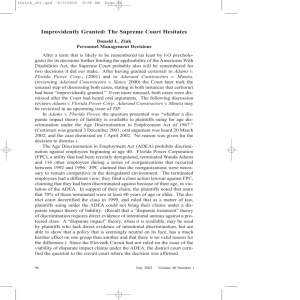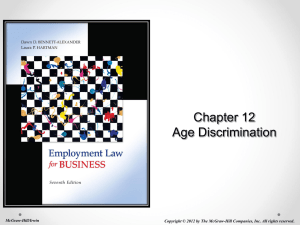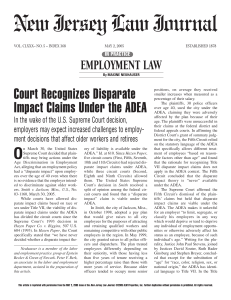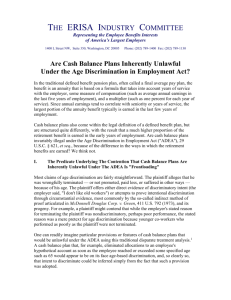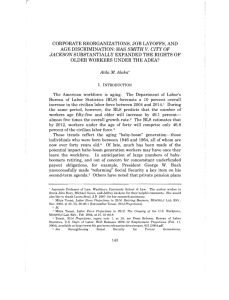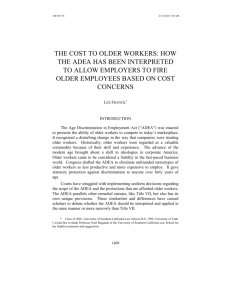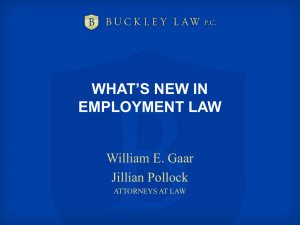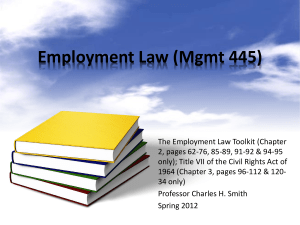A Review of the Legislative History and Judicial Interpretation of the
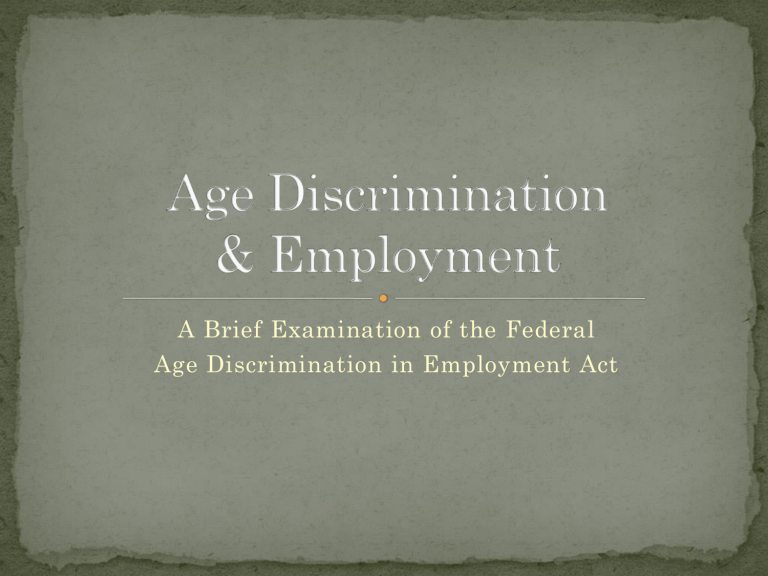
A Brief Examination of the Federal
Age Discrimination in Employment Act
The social policy factors that influence law: In Chapter 16 of his book,
Foundations of Employment Law, Professor John Donohue observes (in
2003) that, in general, the conflict between an increasingly consumerist, youth-oriented culture and the considerable political power and wealth of older Americans has been shaping public policy in the realm of social security, medical insurance, property and income taxes, school finance, and of course, employment, for 30 years. While the elderly have traditionally been economically disadvantaged relative to the rest of society, there have been dramatic advances made by the elderly over the last few decades. Indeed some may argue that the balance may actually be shifting too far in favor of the elderly today. In the employment setting, as chronological age loses its ability to predict functionality and productivity of older workers, the project of formulating specific policies and programs for older workers becomes increasingly difficult.
These competing public policy concerns were clearly contemplated by
Congress as early as 1964, when the Civil Rights Act was being considered, and even then, a proposal to include age within the general provisions against discrimination in employment was eliminated in favor of further study of the issue of age discrimination in employment.
In, 1965, the Department of Labor’s study of the issue of age discrimination in employment revealed that one half of job openings in the private sector arbitrarily disqualified applicants or workers over the age of 45.
Congress was also concerned with the economic advantage to society of retaining older workers in the workforce, and the negative economic impact of unemployment.
These two major concerns led to the enactment, in 1967, of the Age Discrimination in Employment Act (ADEA) “to promote the employment of older persons based on ability rather than age.” The new Act defined older workers as workers or applicants 40 years of age or older. See J.
Donohue, Foundations of Employment Law (Foundation
Press, 2003), Chapter 16, pp. 475-76.
Professors Samuel Issacharoff and Erica Harris argued in 1997 that ageism in the context of employment is driven more by economic calculations that flow from the life-cycle of work than by any invidious prejudice, such as that which characterized race discrimination in the period leading to the enactment of the 1964 Civil Rights Act. Such arguments, which have included Judge Posner’s agreement that the
ADEA is both inefficient and ineffective in achieving its explicit goals, focus on the employer’s right to cost-effectively use age as a proxy for ability to perform, and the concern that the ADEA’s protections serve neither the older worker or society as a whole.
Other scholars, like Professor Lawrence Friedman, a moral theorist, suggest that age discrimination may be compared to race and sex discrimination, noting that employers exploit older workers by terminating them just when they should be benefitting from the rewards of having forgone choices in their earlier marginal-wage career during which the employer is most benefitted by their decision to remain with the employer. See S. Issacharoff & E. Harris, “Is Age Discrimination
Really Age Discrimination,” 72 N.Y.U. L. Rev. (1997); R. Posner, Aging
and Old Age, Univ. of Chicago (1995); L. Friedman, Your Time Will Come
(The Sage Foundation, 1984).
There are two principal theories that define discrimination in employment under 29 U.S.C. § 621-634 (1967): Disparate treatment theory and disparate impact theory. Disparate impact theory is concerned with equal opportunity and prohibits employment practices and policies which appear neutral on their face, but which disproportionally exclude or disqualify classes of persons protected by federal employment nondiscrimination laws. These laws focus on systemic discrimination which is the result of employer practices that may not be explicitly motivated by prejudice. Disparate treatment theory establishes a lower threshold of protection, and seeks only to prohibit discrimination in employment actually motivated by illegal bias,
i.e., the termination of an older worker because s/he is explicitly perceived as having limited skills simply because of her or his age.
Unlike race discrimination jurisprudence, the early ADEA cases focused on the disparate treatment of individual workers or limited classes of older workers. However, both the statute’s text and judicial interpretation draw on comparisons with 42 U.S.C. § 2000e, et seq. The two major differences concern so-called mixed-motive cases and disparate impact cases.
The Equal Employment Opportunity Commission (the federal agency enforcing the ADEA) reported in 2008-2009 that ADEA claims constituted approximately 25% of all claims filed with the
Commission’s field and area offices, and dual filed with state Fair
Employment Practices Commissions like the Florida Human
Relations Commission – a substantial increase since the date of the scholarship referenced earlier in this presentation.
Of no surprise to students of Elder Law, this increase is the result of the increase in the aging of the U.S. workforce. For example, the number of workers over age 65 increased 101% between 1977 and 2007, compared to the 59% increase in total employment generally during that time.
As might be expected, the uniqueness of these cases as compared to other employment discrimination cases filed by minorities and women, is that the plaintiffs in ADEA cases have been mostly white males who have been terminated or the victim of lay-offs that affect relatively higher income, higher status jobs.
In ADEA cases, most courts have applied the analytical approach identified with 42 U.S.C. § 2000e (Title VII cases), most specifically the Court’s decisions in McDonnell Douglas Corp. v. Green, 411 U.S. 792 (1973),
Texas Department of Community Affairs v. Burdine, 450 U.S. 248 (1981), and St. Mary’s Honor Center v.
Hicks, 509 U.S. 502 (1993). This approach, first adopted for ADEA cases in Reeves v. Sanderson Plumbing
Products, 530 U.S. 133 (2000), allows an applicant or employee plaintiff to establish a prima facie case by showing: (1) That he belongs to the protected class; (2) that he applied and was qualified for a job
(promotion)for which the employer was seeking applicants (candidates); (3) that despite his qualifications, he was rejected; and (4) that the employer continued to seek applicants or candidates for the position.
So-called McDonnell-Douglas cases allow an inference of discrimination to be made on the basis of these factors (i.e., a circumstantial case of discrimination), unless the employer comes forward with evidence that, if true, reveals a non-discriminatory reason for disqualification or non-selection. This burden is not a burden of proof, but requires only an articulation of a nondiscriminatory reason; it is a burden of “coming forward” with evidence of nondiscriminatory reasons for a decision. At this juncture, the inference of discrimination falls, and the plaintiff must prove that the proffered reason was pretextual for discrimination.
In Reeves v. Sanderson Plumbing, the Court’s first explicit application of the McDonnell-Douglas paradigm to
ADEA claims, the Court held that proof that the employer’s proffered reason for its action was unworthy of credence is probative of discrimination, at least at the Summary Judgment stage of litigation, and can be persuasive – not compelling, but permitting the jury’s finding of illegal disparate treatment. In other words, the jury may consider the employer’s dishonesty about a material fact as affirmative evidence of discrimination. Courts have made it clear however, that it is not always permissible for the fact finder to infer discrimination, where the record reveals some other nondiscriminatory reason for the employer’s action. In other words, the inference of discrimination must be reasonable.
Even before Reeves, the most important issue in disparate treatment ADEA cases was the employer’s economic motive for termination of workers 40 years of age or older. In Hazen Paper Co. v. Biggens, 507 U.S.
604 (1993), the Court held that there is no disparate treatment of an older worker because of age under the
ADEA when the employer’s decision to terminate the employee is motivated by a factor other than age, including the desire to prevent the employee’s pension benefits from vesting. The Court explained that it was the purpose of the ADEA to prevent an employer from terminating an older worker because the employer arbitrarily believed that the productivity and competence of older workers declines with age. The Court emphasized the purpose of the ADEA to insure that older workers be evaluated on their merits, not their age.
The Court’s decision was based on its earlier holding in Western Air Lines, Inc. v. Criswell, 472 U.S. 400
(1985), where the employer sought to enforce a mandatory retirement policy for airline pilots based on its assumption that pilots over age 50 were as a class disproportionately susceptible to heart issues that would present a danger to passengers. The Court held in Criswell that age may not be used axiomatically as a proxy for disability or incapacity to meet necessary job qualifications unless it is not scientifically or economically feasible for the employer to measure essential job requirements with reference to individual employees.
The Court did limit its decision in Hazen Paper by noting that the Employee Retirement Income Security Act of 1974 (ERISA) may provide relief for an employee who is terminated because of the employer’s desire to prevent the vesting of retirement benefits.
The Court’s holding means that, although age is frequently correlative with the vesting of pension benefits, that correlation alone is not per se proof of age discrimination. This aspect of the Court’s holding reinforces the Court’s basic view of the ADEA as protecting against the arbitrary stereotyping of older workers.
In their casebook on the subject, Professors Avery,
Ontiveros, Corrada, Selmi and Hart include Sperling v.
Hoffman-La Roche, Inc., a federal trial level case reported at 924 F.Supp. 1396 (1996) to illustrate successful and unsuccessful factual claims in a disparate treatment ADEA case:
An allegation that the plaintiff was terminated because he received a relatively high salary, had ample retirement benefits, was about to have vested status in his retirement benefits, was perceived as having an age-related disability, or was over-qualified or over-experienced would not support an
ADEA claim;
An allegation that the plaintiff was terminated and replaced by a substantially younger person, or that he was terminated because it was presumed that he was less productive, less creative, or perceived as having limited ability to acquire skills is sufficient to state a claim under the ADEA.
In subsequent cases, the Court has been divided in its view of Hazen
Paper. In Kentucky Retirement Systems v. EEOC, decided in 2008, the
Supreme Court again reaffirmed its earlier interpretation of the ADEA in Hazen Paper, holding 5-4 that a State Retirement Plan for state and county workers in “hazardous occupations” did not discriminate on the basis of age, even though eligibility for the plan was dependent on an employee’s age-based pension status.
In Gross v. FBL Financial Services, Inc. (2009), the court held (again 5-4) that a claim of age discrimination in employment must include proof that the employer’s consideration of age was the “but for” cause of the adverse employment action that affected the employee, i.e., that age was “the
reason” that the employer acted – that age had a determinative influence
on the outcome (Citing this italicized language in Hazen Paper). The majority reasoned that Title VII is materially different from the ADEA with respect to the burden of proof, and Congress’ amendment of Title
VII to subsume “mixed motive” claims [in 42 U.S.C. §2000e-2(m)] did not alter the language of the ADEA. The Court held that its decision in
Desert Palace v. Costa, 539 U.S. 90 (2003) [interpreting 2(m) to impose limited liability if a protected trait is “a motivating factor” for an adverse employment action] is therefore not applicable to ADEA claims.
Section 623(f)(1) of the ADEA mirrors the language of Title VII of the Civil Rights Act, 42 U.S.C. § 2000e et seq., reaffirmed by
Congress in 1991, stressing “job-relatedness” and “business necessity.” In most of the case books, Western Airlines v. Criswell
(1985) remains the significant case study, and its major lessons are its rejection of the “rational basis-in-fact” test (that age generally increases the risk of physiological and psychological degeneration which per se compromises safety). The Court ruled that any age-related job qualification must be shown to be
“reasonably necessary to the essence of the employer’s business.”
Second, Criswell is important for its holding (mostly in cases where safety is an issue) that age may not be used as a proxy for the demonstration of the absence of necessary skills required by the job, i.e., the employer must prove that substantially all older persons would be unable to perform specific job functions related to safety, or that age is being used as a proxy because it is highly impractical to substantiate the alleged BFOQ via individual assessment.
In Smith v. City of Jackson, 544 U.S. 228 (2005), the city implemented “equity pay increases” for police officers. A class of older officers challenged the pay increases, alleging that they had a disproportionately negative impact on older officers. The Court held that the disparate
impact theory recognized in Title VII cases is applicable to ADEA cases, allowing the older officers to allege that they were “adversely affected” by the plan. The Court noted that in disparate theory cases, the issue is whether the employer’s different treatment of employees is
motivated by age. In contrast, in disparate impact cases, the question whether the employer’s policy or practice is based on a reasonable factor other than age.
On the merits, the Court held that the city’s plan was based on “reasonable factors other than age.” First, the plan, which was motivated by the city’s concern to bring its police salaries into line with other cities, established pay ranks that included officers under 40 and officers over
40. The gravamen of the plaintiffs’ complaint was that the equity adjustments, when applied to officers in higher ranks awarded lesser percentage increases in pay to older officers, who dominated those ranks, even though the dollar amount of the increases still comparatively favored older officers. The critical factor that satisfies the ADEA’s concern is that the adjustments that were implemented were based on seniority and position, not age, i.e., the city’s decision to grant a larger percentage equity adjustment to lower rank police officers, for the purpose of bringing police salaries in line with salaries in comparable surrounding communities, is based on reasonable factors other than age, consistent with the ADEA. [Smith is a plurality opinion, with a majority agreeing only that the ADEA recognizes a class claim based on disparate impact theory]. Meacham v. Knolls Atomic Power Laboratory, 128 S. Ct.
2395 (2008) clarifies that the employer rather than the employee has the burden of proof on the RFOA issue. The Court holds that the employer must both produce such evidence and carry the burden of persuasion.
Periods of economic downturn, the ongoing development of technology that replaces the need for human labor, concerns for global competitiveness, and a “free-market” philosophy which embraces the interests of top management and investors, have combined to expand the scope of so-called “reductions-in-force” – large scale lay-off programs which arguably victimize older workers. Do these background factors present a reason for the Supreme Court to reconsider its interpretation of the ADEA, or for Congress to expand the scope of the ADEA’s protection of older workers based on economic policy?
Professor Gary Minda and others have argued that older workers are particularly vulnerable to corporate downsizing and job displacement, and that the ADEA should explicitly or by interpretation recognize that employers use age as a factor in making downsizing decisions. Whether or not we call this “wage bias” theory (motivated by corporate concern for profit), some courts have recognize that an employer’s decision might be challenged if it replaces the employee at a lesser cost, as contrasted with assigning the tasks to another employee or otherwise truly eliminating or redistributing the work.
Six Circuit Courts (but not the 11 th ) have adopted this approach and have allowed the plaintiff or plaintiff class to establish a
prima facie case by showing that: (1) S/he is 40 years of age or older; (2) S/he was qualified for the job and was terminated pursuant to a “downsizing” decision; (3) S/he was a late-career employee; and (4) S/he was disadvantaged in favor of a younger person, or laid-off for being too expensive to the company.
The employer could overcome the inference of discrimination by showing that the termination was the result of technological restructuring, reduced demand for the company’s products or services, or outsourcing or other strategies that do not target older workers. See G. Minda, “Opportunistic Downsizing of Older
Workers,” 48 Hastings L. J. 511 (1997); J. Lind, “The Prima Facie
Case of Age Discrimination in Reduction-in-Force Cases,” 94
Mich. L. Rev. 832 (1995).
Observing the workplace and your own working career to date, how, if at all, have the assumptions presented in the first part of the PowerPoint changed in the past
15 years? If your background is still principally scholastic, how can you overcome the disadvantage of a purely academic background if your legal practice includes or focuses on discrimination in employment?
The cases presented appear to reveal that the Supreme Court remains concerned about protecting the older worker when age becomes a proxy for inability to learn, diminished skills, or lack of productivity, i.e., the arbitrary stereotyping of older workers. Thus the Court appears to continue to see the issue of the employer’s economic motives for termination, including reductions in force, as the subject of economic legislation such as ERISA. Is the Court’s view of the ADEA as a law protecting against arbitrary stereotyping of older workers a legitimate view of the
ADEA’s legislative history and Congress’ purpose, or should the Court recognize an expanded analytical approach to ADEA cases that more directly recognizes the economic interests of older workers?
How does the issue of age discrimination in employment relate to other social issues and social policy (moral or economic) that are the subject of Elder Law?

